Rebecca’s Recipe of the Week: Pasta with Creamy Carrot Miso Sauce
Another very good recipe from Slyvia Fontaine. The creamy carrot sauce colours the pasta a beautiful gold, while the fresh, herby gremolata adds vibrant green. Toasted breadcrumbs provide a contrasting crunch against the richness of the sauce. You would certainly not guess that this is vegan, but you’ll see right away how beautiful it looks in your bowl. The flavours work really well together and I recommend this highly.
Pasta with Creamy Carrot Miso Sauce
Serves 4
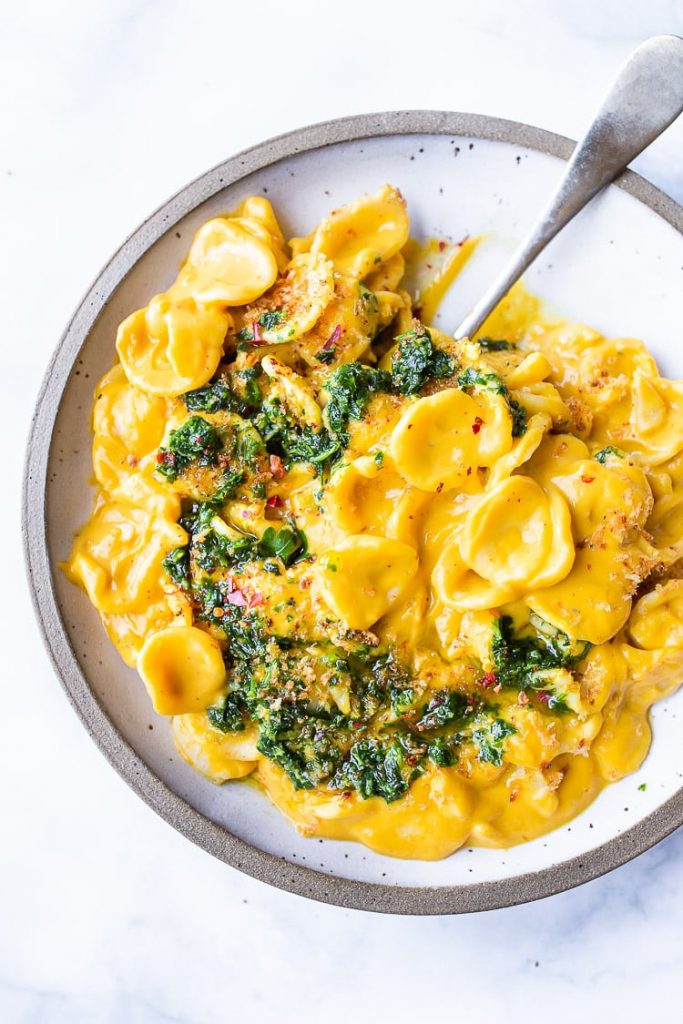
Ingredients
Carrot Miso Sauce
2 shallots, rough chopped (or 1/2 an onion)
3 large garlic cloves, rough chopped
2 tablespoons olive oil
150g carrots
450ml water
40g cashews
Freshly-ground pepper
3 tablespoons white miso paste
Gremolata
60g fresh coriander or parsley (Sylvia notes you can also use carrot tops)
1 tablespoon lemon zest ( zest from one medium lemon)
¼ teaspoon salt
1 fat garlic clove
70-100ml olive oil
Toasted Breadcrumbs
1 thick slice of good bread, grated, to make about 50g breadcrumbs
250g pasta (Sylvia Fontaine recommends orecchiette)
Instructions
Cook the sauce: Heat oil in a medium pot, over medium heat. Saute shallot and garlic until fragrant and golden, about 5 minutes, stirring often. Add carrots, cashews, water, and pepper and bring to a boil. Cover, lower heat to low and simmer gently until carrots are fork-tender, about 15 minutes. Stir in the 3 tablespoons of miso and let cool for 5-10 minutes.
While the carrots simmer make the Gremolata: Place coriander or parsley, lemon zest, salt and garlic in a food processer and pulse repeatedly until finely chopped. Add 70ml oil, pulsing a few more times until incorporated (but not too smooth). Add more oil if you prefer a looser version.
Now make the breadcrumbs: place the breadcrumbs in a frying pan over medium heat and toast, stirring frequently, until the crumbs are golden brown. Set aside.
Bring some water to the boil, and cook the pasta according to the packet instructions.
While the pasta is cooking blend the sauce: place the carrot-cashew sauce in a high-speed blender or food processor and blend on the lowest setting, gradually increasing speed, until fully blended, creamy and silky smooth, which will take between one and two minutes. Slyvia writes: ‘Take your time here and get it SMOOTH!!!’
Drain the pasta and pour the sauce over. Heat it gently if needed. Taste and adjust salt.
Divide among bowls, and sprinkle with toasted bread crumbs and spoon the gremolata over top. Enjoy with a glass of chardonnay.
Recipe adapted from Sylvia Fontaine, Feasting at Home
Rebecca’s Recipe of the Week: Why Eat Normal Things When You Can Eat Weird Things?
A while ago I tried a recipe for whole broad beans cooked in a tomato sauce, and it was pretty good. It set me thinking whether you could actually cook the normally-discarded pods (husks?) that are left over when you shell broad beans. It turns out you can. I mentioned this to several friends, who variously told me I’d gone nuts, or that it sounded like the sort of thing people eat in Siberia. What can I say? I thought it was pretty good. We ate this with brown rice and a topping of salted yoghurt, and a shredded carrot salad on the side.
If you would like a normal recipe for broad beans, I strongly recommend this one: spaghetti with broad beans, bread crumbs and marjoram.
Broad Bean Stew
Serves 2
Ingredients
2 tablespoons olive oil
1 large onion, peeled and sliced
Salt and pepper
Leftover husks from about 500g young broad beans (that’s about 300g of broad-bean husks)
Juice of half a lemon
2-3 tablespoons fresh herbs (I used lemon thyme, sage, and dill)
½ cup water
Preparation
Heat the olive oil over low heat and add the sliced onion and a pinch of salt. Cook for 10 minutes, until the onion is soft but not brown.
Meanwhile assess the broad bean husks. You want bright, green, fresh-looking ones. Discard any that look discoloured. Remove any stringy bits along the sides, rather as you’d remove the strings from off the sides of runner beans. Cut the husks into 1-inch pieces.
Add the broad beans to the onions, stir, and cook for a minute.
Add the water, stir, cover, and simmer gently for about 15 minutes, or until the husks are tender. Top up with more water if it seems to be drying out.
Once the husks are tender, add the fresh herbs and lemon juice, and season with freshly-ground black pepper.
If you wish, you can also mix in some cooked broad beans, to make a double-broad-bean stew.
Serve on brown rice with a topping of salted yoghurt mixed with preserved lemon (if you happen to have any to hand).
Rob’s Recipe of the Week: Spring Dal
We’re getting some huge spring greens at the moment and I’ve discovered a few new recipes involving them as a result. I make Dhal fairly regularly but rarely follow a recipe. This one is a really good introduction though, I was quite amazed at how rich it tasted and I’m really not sure what the difference was to my usual attempts! Make sure you cook until the lentils are soft, I’m often too impatient.
Spring Green and Coconut Dal

Ingredients (Serves two)
1 tbsp coconut oil
1 onion, finely sliced
1 large or 2 small garlic cloves, finely chopped, grated or crushed
4cm piece of fresh ginger, peeled and finely grated
1 red chilli, finely sliced
1 tsp black mustard seeds
¼ tsp ground turmeric
1 x 400ml tin coconut milk
100g yellow mung dal lentils, rinsed in a sieve (I used red lentils)
1 tsp coriander seeds, toasted and ground
1 tsp cumin seeds, toasted and ground
200g spring or summer greens, tough ribs removed (sliced them and fired with the onion), leaves finely shredded. Feel free to go heavy on the greens I found they worked well.
handful of coriander leaves
a squeeze of lime or lemon juice
toasted coconut chips or toasted desiccated coconut, to garnish
salt
Method
Prep time: 5 min
Cooking time: 50 min
Melt the coconut oil in a large pan. Add the onion and fry on a low heat for 10 minutes, stirring occasionally.
Turn up the heat a little and add the garlic, ginger, chilli, mustard seeds and turmeric. Stir for about 1 minute, until you hear the mustard seeds start to pop. Stir the coconut milk in the can then pour into the pan with the lentils and ground coriander and cumin. Fill the coconut milk can half full with water and add that too.
Bring up to the boil, reduce the heat and simmer for about 15 minutes. Add the greens, stirring in small handfuls at a time, then cook for a further 5–10 minutes, until the lentils are tender and the greens wilted. Keep an eye on the liquid and add more water if needed.
Season the dal with salt, stir in the fresh coriander and add a squeeze of lime or lemon juice to taste. Serve the dal prinkled with toasted coconut and a few extra coriander leaves.
Adapted from: https://www.riverford.co.uk/recipes/spring-green-and-coconut-dal
Erica’s Recipe of the Week: Sweet, rich and sour Indian vegetable stew
Thanks to Erica Moody for suggesting this recipe from Meera Sodha’s column in last week’s Guardian Food.
Meera says: There might seem to be a lot of chillies in this, but it’s not a hot dish, because the natural sweetness of the squash and sweetcorn, combined with the rich coconut milk and spiky lime, balance things out. Fresh curry leaves are now sold in most major supermarkets.
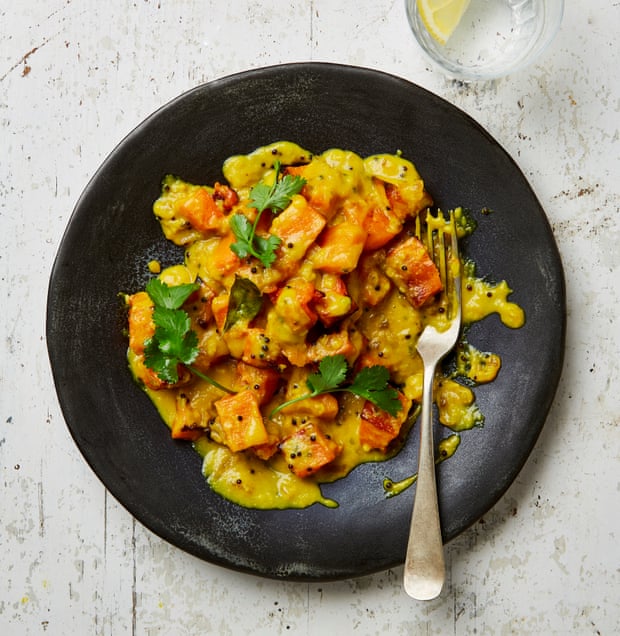
Butternut squash and sweetcorn erriseri
Prep 10 min
Cook 45 min
Serves 4
Ingredients:
1kg squash, washed
Sunflower oil
Fine sea salt
1 x 340g tin sweetcorn, drained
2 tsp black mustard seeds
12 curry leaves
1 large onion, peeled and finely chopped
4 garlic cloves, peeled and minced
3 green finger chillies, finely chopped
2 tsp turmeric
1 x 400ml tin coconut milk
2 tbsp fresh lemon juice (ie, from 1 lemon)
Coriander leaves, to garnish
Method:
Cut the squash in half (no need to peel), scoop out and discard the seeds, then cut it into 2cm cubes. Heat the oven to 200C (180C fan)/gas 6. Tip the squash pieces on to an oven tray, pour over two tablespoons of oil and a good sprinkling of salt, and toss to coat. Bake for 25-30 minutes, until the squash chunks are tender and their edges caramelised.
Add two tablespoons of water to the drained sweetcorn kernels and blend to a smooth paste (I use a stick blender).
In a large frying pan, heat two tablespoons of oil and, when hot, add the mustard seeds and curry leaves, and leave them to crackle and pop for a minute. Now add the onion and cook, stirring occasionally, for about 10 minutes, until translucent and turning golden, then add the garlic and chillies, and cook for two minutes. Stir in the sweetcorn paste, turmeric and a teaspoon and a half of salt, cook for a minute, then add the coconut milk (keep the tin) and whisk so everything is combined and the curry sauce is a vibrant yellow.
Half-fill the coconut milk tin with water and add to the pot to loosen the curry – you may need a little more or less water than this, depending on the thickness of your coconut milk – bring to a boil and simmer for five minutes, until it starts to thicken. Stir in the roast squash and lemon juice, and check the seasoning. Garnish with coriander and serve immediately.
Adapted from Guardian Food, 20th March 2020
Rebecca’s Recipe of the Week: In Praise of Potatoes
In honour of the recent potato harvest, here is a splendid Nepalese potato salad from the Idaho Potato Commission. The Andean potato probably reached Nepal some time in the 1700s; it is now become a staple. In 2017 the country harvested 2,691,037 tonnes. This salad combines potatoes, fresh coriander, and spiced yoghurt to create a complex and satisfying dish. Eat with shredded carrot salad, and perhaps some flatbread.
The Potato Commission thinks this will serve 4 people, but we ate most of it in one sitting. ‘This is scrum’ declared Matt.
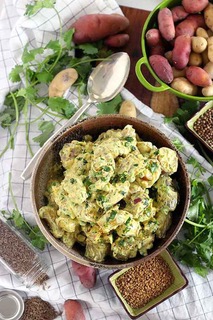
Chukauni: Nepalese Potato Salad
Ingredients
700g potatoes
1 cup frozen peas
½ cup red onion, finely chopped
½ cup fresh coriander, finely chopped
1 cup yoghurt, plus additional yoghurt, to serve
1 teaspoon salt
2 tablespoons rapeseed or vegetable oil
1 tablespoon coriander seeds
1 teaspoon cumin seeds
1 teaspoon fenugreek seeds
½ Canalside chile, finely chopped, seeds removed if desired
½ teaspoon turmeric
Preparation
Place the potatoes in a pot of cold water and bring slowly to the boil. Cook over very low heat until tender. Fish out the potatoes, drain, and set aside, keeping the water in the pan. Turn off the heat and then tip the peas into the hot water. Leave them there for 60 seconds and then drain them as well.
Once the potatoes are cool enough to handle, cut them into 2cm cubes.
Combine the peas, red onion, coriander, yoghurt and salt in a serving bowl. Stir and add the potatoes.
Heat the oil in a frying pan over medium-high heat. Once it is hot add the coriander, cumin and fenugreek seeds. Let sizzle for about 30 seconds, until they turn reddish brown. Remove from the heat and add the chile and turmeric. Toss so that the oil turns a sunny yellow.
Pour the oil–but not the seeds—over the salad. Keep as many seeds as possible back in the pan. Mix the oil into the salad and taste.
Now you have a choice: if the salad strikes you as perfectly delicious as it is, then you’re done. Serve and enjoy, with additional yoghurt on the side if you like.
If you think it needs a little more oomph, then scrape the seeds into a mortar and pestle and grind them until they’re a coarse powder. Sprinkle some or all of this into the salad, tasting as you go along. Once you’re pleased with the result, serve and enjoy.
Recipe adapted from the Idaho Potato Commission.
Rob’s Recipe of the Week: Vegan ‘omelette’ for filling
I picked up this recipe whilst living in Gothenburg and it has great connotations for me with sunny breakfasts on the pier… Hopefully I don’t just see it with rose tinted glasses!
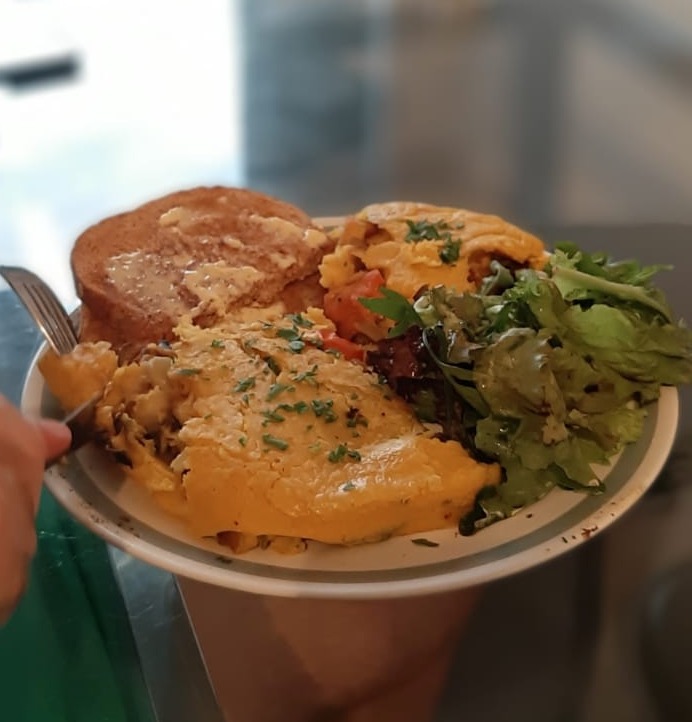
Vegan chickpea flour (kikärtsmjöl) omelette
Ingredients
1 cup (120 g) chickpea flour
1 Tablespoon flaxseed meal or chia seed meal (optional)
1/2 tsp (0.5 tsp) salt
1/4 tsp (0.25 tsp) each of turmeric garlic powder, baking soda, cumin powder
1ish cup of waterFillings!
Fried tomato, onion, mushrooms, lots coming in our shares that could suit!
Method is simple, mix the all the dry ingredients then add the water slowly and mix with a whisk until they take on the same consistency as whisked eggs. Fry up the fillings, then poor on the omelette mix and reduce pan to a medium to low heat. Make sure you cook it slower and longer than an egg omelette – it tends to burn before solidifying enough to flip if you rush it.
Rob’s Recipe of the Week: Dinner on the run
I went to a very interesting sports food recovery workshop with a nutritionist called “whole food warrior” whilst at a running festival earlier in the summer. This is one of her recipes which should be pretty quick and simple, enjoy!
Chickpea, green bean & spinach curry (15-minute recipe)
Ingredients (feeds 2)
For the curry paste:
A handful of fresh coriander, stalks & leaves (10-15g)
1/2 green pepper (75g), roughly chopped
1 red chilli, roughly chopped
1/2 thumb size piece of ginger (15g), peeled and roughly chopped
1 small onion (55g), peeled and roughly chopped
1 turmeric root or 1/4 teaspoon of turmeric powder
1/2 lemon, peeled (you are using the actual lemon here, not the rind)
1 teaspoon of cumin seeds
1/2 teaspoon of cinnamon
sea salt and freshly ground black pepper
Other ingredients:
150g of dwarf beans or green beans
1 tin of chickpeas
1/2 a tin of chopped tomatoes (200ml)
1/2 a tin of coconut milk (200ml)
4 large handfuls of spinach (approximately 120g)
Method:
Put all of the curry paste ingredients in a blender, season with a pinch of sea salt and some freshly ground black pepper and blend until smooth. Add a splash of water to make the bending easier if needed.
Put a frying pan on a medium high heat. Tip in the curry paste and cook until it thickens to a paste, approximately 5 minutes.
Pour in the chopped tomatoes and coconut milk, stir well, season with a little bit more sea salt and black pepper.
Add the green beans and cook for 5 minutes.
Tip in the chickpeas and spinach and cook for a further 5 minutes until the sauce has thickened.
Check the taste and season with more black pepper and sea salt if needed.
To serve, simply divide the curry between two large bowls. Sprinkle on some extra coriander leaves if desired.
Taken from: https://wholefoodwarrior.co.uk/blog/quickcurry
16th aug
Rebecca’s Recipe of the Week: Green Beans, Tomatoes and Saffron
Serve this lovely blend of tomatoes, beans and saffron-scented onions as a side dish, or alongside some polenta topped with a poached egg. It’s also tasty accompanying plain white fish.
Fagiolini in umido all zafferano
Serves 4 as a side dish.
Ingredients
10 medium tomatoes
60ml olive oil
2 medium onions, peeled and thinly sliced
1 small pinch of saffron
650g green beans, topped and tailed
Preparation
Bring a medium pot of water to the boil. Prepare a bowl of ice water.
Score the bottom of each tomato with a X, using a sharp knife, and remove the core. Drop the tomatoes into the boiling water a few at a time, and cook for about 30 seconds each, until the skin starts to loosen. Remove with a slotted spoon and drop into the bowl of ice water. Don’t discard the hot water: you’ll use it to cook the beans.
Fish each tomato out of the ice water and slip off the skin. Dice into small cubes.
Put the olive oil and sliced onions into a saucepan over very low heat. Add a pinch of salt and the saffron. Cook gently for 20-25 minutes, or until the onions are soft and translucent. Stir occasionally and make sure they don’t catch or burn.
Add the diced tomatoes and cook for 10 more minutes. Season with salt.
Bring the tomato water to a boil, salt, and cook the beans for 6 minutes, or until tender. Drain the beans and add to the onion-saffron-tomatoes. Simmer for 3 more minutes over low heat and serve.
Recipe adapted from Christopher Boswell and Elena Goldblatt, Verdure: Vegetable Recipes from the American Academy in Rome (2014).
Rebecca’s Recipe of the Week: Carrots with Pickled Raisins
Pickled raisins are very now, in case you didn’t know. This is a very good salad, in any case.
Carrot Salad with Yoghurt, Pickled Raisins and Nuts
Serves 2
Ingredients
2 tablespoons soft brown sugar (dark or light, as you prefer)
2 tablespoons apple cider vinegar
1 handful raisins (or sultanas)
200g carrots, peeled
1 tablespoon olive oil
Salt and pepper, to taste
2 tablespoons preserved lemon, chopped
1 handful pistachios or cashews, toasted briefly in a dry pan and roughly chopped
1 handful fresh coriander (or other herbs), roughly chopped
3 tablespoons yoghurt
Preparation
Combine the sugar and vinegar in a small bowl. Add the raisins and leave to soak for at least 10 minutes, or as long as you like. (I marinated mine for 4 days, at room temperature.) These are the pickled raisins.
Using a vegetable peeler, shave the carrots into thin curls into a bowl, or grate them coarsely.
Dress the carrots with the oil, salt and pepper, and preserved lemon. Mix in the raisins and soaking liquid, nuts, and herbs. Drizzle with the yoghurt and serve.
Recipe adapted from Abra Berens, Ruffage: A Practical Guide to Vegetables (2019).
Rebecca’s Recipe of the Week: Spicy Coconut Cauliflower
Cumin-scented cauliflower, yellow from turmeric, cooks with Canalside chile and a subtle coconut-poppy seed glaze. The result is spicy, satisfying and beautiful. Eat it topped with toasted almonds, fresh coriander, yoghurt and a squeeze of lime. Yotam recommends serving with flatbread, but it’s pretty delicious just on its own.
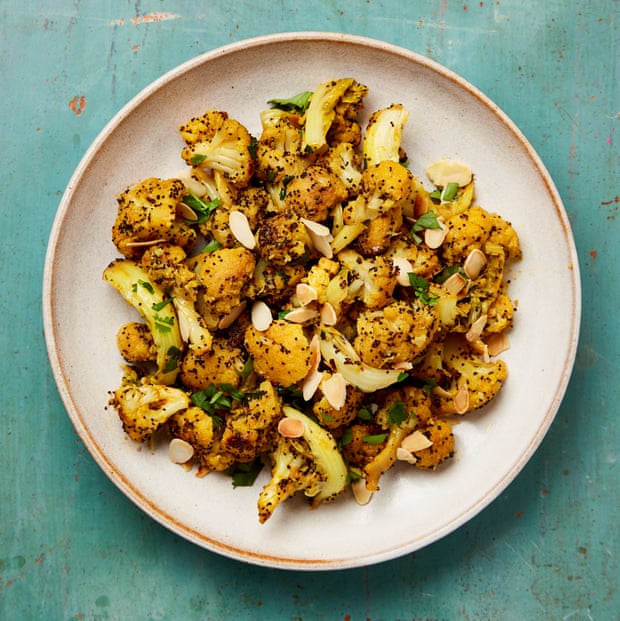
Poppy-Seed Cauliflower with Coconut
Serves 2
Ingredients
40g poppy seeds
60ml sunflower oil
½ – 1 Canalside dried red chile, de-seeded if desired, and shredded
1 teaspoon turmeric
1 teaspoon cumin seeds
2 garlic cloves, peeled and sliced fine
1 large cauliflower and leaves, broken into 4cm-sized florets, leaves shredded
150ml coconut milk (approx.)
To serve
1 handful fresh coriander, shredded
1 small handful flaked almonds, lightly toasted in a dry pan
plain yoghurt
1 lime, halved
Preparation
Put the poppy seeds in a small bowl. Pour over just enough boiling water to cover them. Leave them for half an hour, and then whiz them in a blender or food processor, or crush them in a mortar and pestle, so that they begin to break up a bit. Set aside.
Heat the oil over medium-high heat in a large sauté pan for which you have a lid. When it is hot add the chile, turmeric, cumin and garlic. Turn the heat to medium and sauté for 4 minutes, stirring often, until the garlic starts to brown and the mixture gives off a nice smell.
Add the cauliflower leaves and florets and toss with the spices. Stir for 2 minutes, until the cauliflower has turned an attractive yellow.
Add the coconut milk and the poppy seeds. Add enough coconut milk to make a little sauce, but not so much that it is soupy. Turn the heat down a little and cover. Cook for 4 more minutes, until the cauliflower has begun to soften.
Uncover and turn the heat up to medium-high. Cook for 8 more minutes, stirring regularly, until the cauliflower is tender and has begun to caramelise and the liquid has evaporated.
Serve topped with fresh coriander, toasted almonds, yoghurt and a squeeze of lime.
Recipe adapted from Yotam Ottolenghi, The Guardian, 16 Feb. 2019.
Rebecca’s Recipe of the Week: Salad Improvisation
I got home late last night so dinner was a spontaneous improvisation based on what was in the fridge. The result proved to be very tasty! The smooth roasted peppers (you could use sun-dried tomatoes, I think) combine with the crunch of the celery and the boiled potatoes to give a satisfying complexity. A salty miso dressing pulls it all together.
You could serve this with a poached egg, or some grilled meat or fish, or, to be honest, on its own. You could add some feta, as well. I’ve not given precise quantities; that would go against the entire spirit of this dish.
Potato-Pimento Salad with Miso and Herbs
Ingredients
The salad
Potatoes
Celery, sliced
Tinned Spanish pimientos de padrón, sliced, or sun-dried tomatoes, sliced
Lots of fresh parsley and/or coriander, coarsely chopped
Toasted pumpkin seeds, or almonds
The dressing
1 part miso paste
2 parts olive oil
1 part lime juice
Lime zest
Freshly-ground pepper
Preparation
Put the potatoes in a pan and cover with cold water. Bring slowly to the boil, and simmer very gently until the potatoes are tender.
While the potatoes cook, combine the other salad ingredients in a bowl and shake the dressing ingredients together in a jar.
Drain the potatoes and leave to dry off a bit for a few minutes. Once they’re cool enough to handle, cut them into chunks and add them to the salad. Toss well and serve with additional black pepper, to taste.